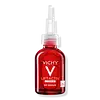What's inside
What's inside
 Key Ingredients
Key Ingredients

 Benefits
Benefits

 Concerns
Concerns

 Ingredients Side-by-side
Ingredients Side-by-side

Water
Skin ConditioningC12-13 Alkyl Lactate
EmollientVitis Vinifera Seed Oil
EmollientGlycerin
HumectantButylene Glycol
HumectantBis-Ethylhexyloxyphenol Methoxyphenyl Triazine
Skin ConditioningSteareth-21
CleansingEthylhexyl Methoxycinnamate
UV AbsorberSteareth-2
EmulsifyingKojic Acid
AntioxidantPetrolatum
EmollientStearyl Alcohol
EmollientCetearyl Alcohol
EmollientCyclopentasiloxane
EmollientDimethicone
EmollientAluminum Silicate
AbrasiveAscorbyl Methylsilanol Pectinate
AntioxidantLactic Acid
BufferingCoco-Glucoside
CleansingIsohexadecane
EmollientCyclohexasiloxane
EmollientPotassium Cetyl Phosphate
EmulsifyingSodium Acrylate/Sodium Acryloyldimethyl Taurate Copolymer
Emulsion StabilisingAmmonium Acryloyldimethyltaurate/Vp Copolymer
Stearic Acid
CleansingAluminum Hydroxide
EmollientPolysorbate 80
EmulsifyingPhenoxyethanol
PreservativeO-Cymen-5-Ol
AntimicrobialDisodium EDTA
BHT
AntioxidantSodium Sulfite
PreservativeSodium Metabisulfite
AntioxidantWater, C12-13 Alkyl Lactate, Vitis Vinifera Seed Oil, Glycerin, Butylene Glycol, Bis-Ethylhexyloxyphenol Methoxyphenyl Triazine, Steareth-21, Ethylhexyl Methoxycinnamate, Steareth-2, Kojic Acid, Petrolatum, Stearyl Alcohol, Cetearyl Alcohol, Cyclopentasiloxane, Dimethicone, Aluminum Silicate, Ascorbyl Methylsilanol Pectinate, Lactic Acid, Coco-Glucoside, Isohexadecane, Cyclohexasiloxane, Potassium Cetyl Phosphate, Sodium Acrylate/Sodium Acryloyldimethyl Taurate Copolymer, Ammonium Acryloyldimethyltaurate/Vp Copolymer, Stearic Acid, Aluminum Hydroxide, Polysorbate 80, Phenoxyethanol, O-Cymen-5-Ol, Disodium EDTA, BHT, Sodium Sulfite, Sodium Metabisulfite
Water
Skin ConditioningButylene Glycol
HumectantNiacinamide
SmoothingHydroxyethylpiperazine Ethane Sulfonic Acid
BufferingGlycerin
HumectantHydroxyethyl Urea
HumectantPropylene Glycol
HumectantGlycolic Acid
BufferingTranexamic Acid
AstringentAllantoin
Skin ConditioningSodium Hydroxide
BufferingPhenoxyethanol
PreservativeChlorphenesin
AntimicrobialAscorbyl Glucoside
AntioxidantCaprylyl Glycol
EmollientHydrolyzed Rice Protein
Skin ConditioningVitreoscilla Ferment
Skin ConditioningTrisodium Ethylenediamine Disuccinate
Xanthan Gum
EmulsifyingPentylene Glycol
Skin ConditioningWater, Butylene Glycol, Niacinamide, Hydroxyethylpiperazine Ethane Sulfonic Acid, Glycerin, Hydroxyethyl Urea, Propylene Glycol, Glycolic Acid, Tranexamic Acid, Allantoin, Sodium Hydroxide, Phenoxyethanol, Chlorphenesin, Ascorbyl Glucoside, Caprylyl Glycol, Hydrolyzed Rice Protein, Vitreoscilla Ferment, Trisodium Ethylenediamine Disuccinate, Xanthan Gum, Pentylene Glycol
 Reviews
Reviews

Ingredients Explained
These ingredients are found in both products.
Ingredients higher up in an ingredient list are typically present in a larger amount.
Butylene Glycol (or BG) is used within cosmetic products for a few different reasons:
Overall, Butylene Glycol is a safe and well-rounded ingredient that works well with other ingredients.
Though this ingredient works well with most skin types, some people with sensitive skin may experience a reaction such as allergic rashes, closed comedones, or itchiness.
Learn more about Butylene GlycolGlycerin is already naturally found in your skin. It helps moisturize and protect your skin.
A study from 2016 found glycerin to be more effective as a humectant than AHAs and hyaluronic acid.
As a humectant, it helps the skin stay hydrated by pulling moisture to your skin. The low molecular weight of glycerin allows it to pull moisture into the deeper layers of your skin.
Hydrated skin improves your skin barrier; Your skin barrier helps protect against irritants and bacteria.
Glycerin has also been found to have antimicrobial and antiviral properties. Due to these properties, glycerin is often used in wound and burn treatments.
In cosmetics, glycerin is usually derived from plants such as soybean or palm. However, it can also be sourced from animals, such as tallow or animal fat.
This ingredient is organic, colorless, odorless, and non-toxic.
Glycerin is the name for this ingredient in American English. British English uses Glycerol/Glycerine.
Learn more about GlycerinPhenoxyethanol is a preservative that has germicide, antimicrobial, and aromatic properties. Studies show that phenoxyethanol can prevent microbial growth. By itself, it has a scent that is similar to that of a rose.
It's often used in formulations along with Caprylyl Glycol to preserve the shelf life of products.
Water. It's the most common cosmetic ingredient of all. You'll usually see it at the top of ingredient lists, meaning that it makes up the largest part of the product.
So why is it so popular? Water most often acts as a solvent - this means that it helps dissolve other ingredients into the formulation.
You'll also recognize water as that liquid we all need to stay alive. If you see this, drink a glass of water. Stay hydrated!
Learn more about Water